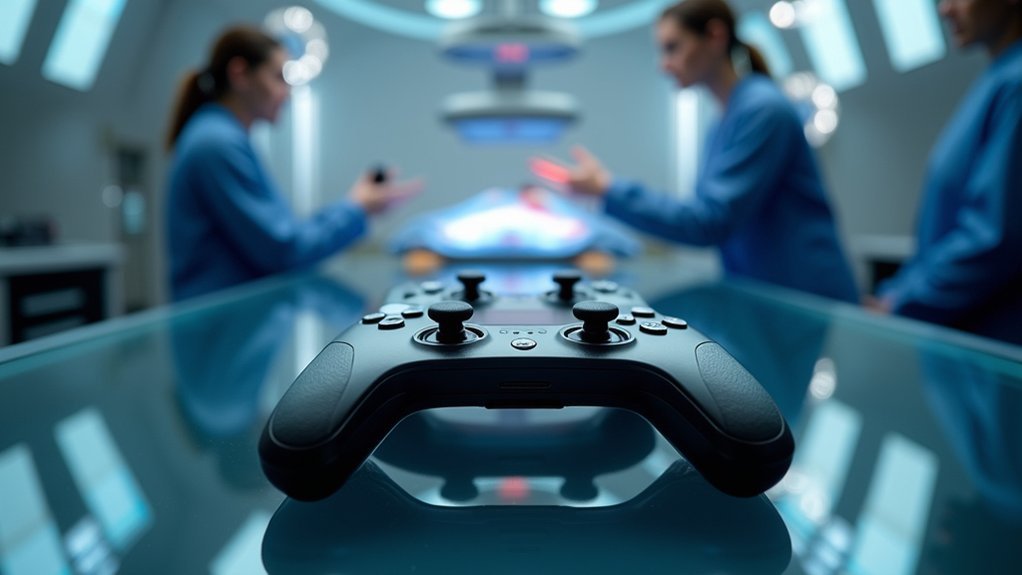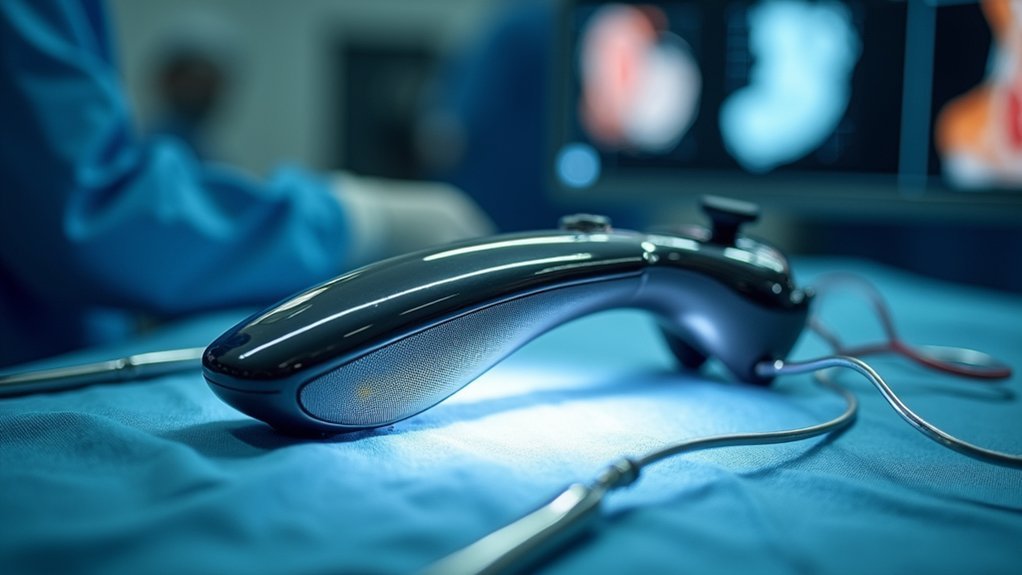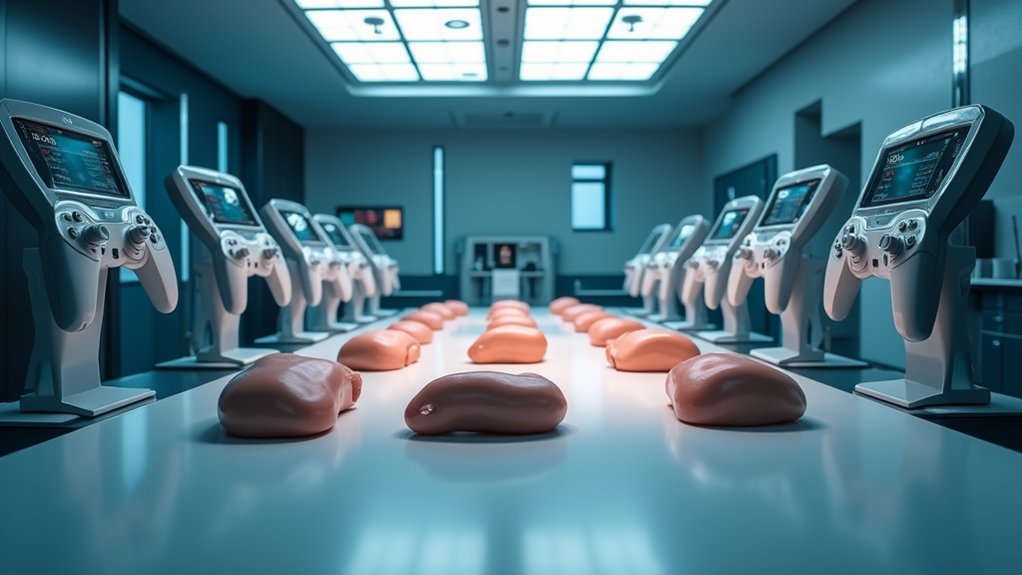You’ll discover precision controllers revolutionizing surgical training through medical-grade VR platforms, haptic feedback systems, and force-sensing robotic trainers that create immersive operating room environments. These advanced controllers utilize AI-enhanced tracking with sub-millimeter accuracy, reducing errors by 78% while providing real-time performance monitoring and multi-modal input devices. They’re transforming novice students into skilled surgeons through modular training solutions, bilateral hand control systems, and immersive proprioceptive feedback that prepares you for complex procedures ahead.
PrecisionOS Medical-Grade VR Platform Controllers

Precision transforms surgical education when you’re using PrecisionOS’s medical-grade VR controllers, which create an immersive operating room environment that rivals real-world training.
You’ll interact with virtual anatomical structures and surgical instruments through these advanced controllers, experiencing realistic haptic feedback that mirrors actual surgical procedures.
The platform’s sophisticated sensors enable deliberate practice while providing immediate feedback, accelerating your skill development in surgical training scenarios.
Whether you’re mastering traditional techniques or learning robotic surgery procedures, the controllers adapt to your specific learning needs through modular, competency-based training modules.
Adaptive VR controllers deliver personalized surgical training through modular, competency-based modules that adjust to individual learning requirements and skill levels.
You’ll benefit from cost-effective, scalable technology that makes high-quality surgical education accessible regardless of your location.
The controllers integrate proven learning theories, ensuring you develop expertise through evidence-based methodologies that enhance retention and practical application.
Haptic Feedback Systems for Surgical Simulation
When you grasp virtual surgical instruments through advanced haptic feedback systems, you’re experiencing tactile sensations that precisely replicate the forces and resistance encountered in actual surgery.
These sophisticated controllers utilize cutting-edge sensors to measure and recreate authentic surgical forces, enabling you to develop surgical precision through realistic practice scenarios.
You’ll master delicate procedures like suturing and tissue manipulation within controlled environments, eliminating patient risks while building essential skills.
Studies demonstrate that haptic feedback greatly enhances skill retention and knowledge acquisition, preparing you more effectively for real operating rooms.
This technology accelerates your progression from novice to proficient surgeon by reducing learning curves.
You’ll shift seamlessly between virtual training and actual procedures, as your muscle memory develops through consistent haptic experiences that mirror genuine surgical conditions.
Force-Sensing Robotic Training Controllers

Advanced force-sensing robotic training controllers revolutionize how you’ll develop surgical expertise by measuring the exact pressure and torque you apply during simulated procedures.
These sophisticated systems utilize miniature load cells and multi-axis sensors to deliver high-accuracy feedback that’s essential for minimally invasive surgery training. You’ll experience real-time force measurement that mimics the delicate complexities of actual robotic-assisted and laparoscopic procedures.
When you’re practicing with force-sensing robotic training controllers, you’re developing the precision and accuracy required for safe surgical practices.
These controllers optimize surgical tool design, reducing fatigue while improving your performance with robotic arms and staplers. The technology simulates authentic surgical scenarios, allowing you to master force application techniques that directly translate to enhanced patient outcomes through refined surgical competency.
Multi-Modal Input Devices for OR Environments
Integration of multi-modal input devices transforms your surgical training experience by combining haptic feedback controllers, motion tracking systems, and voice-activated commands into extensive learning platforms.
You’ll interact through touch, voice commands, and gesture controls, creating immersive simulations that engage multiple senses simultaneously. These multi-modal input devices enhance retention of skills and knowledge by providing varied interaction methods that mirror real operating room environments.
Research demonstrates that incorporating advanced input devices in surgical training greatly reduces your learning curve while improving your shift from theoretical knowledge to practical application.
You’ll develop confidence and accuracy through realistic simulations that prepare you for complex procedures. Implementation of these technologies becomes increasingly essential as training programs evolve to meet modern surgical demands and expectations.
AI-Enhanced Precision Tracking Controllers

You’ll find that AI-enhanced precision tracking controllers revolutionize surgical training through sophisticated machine learning algorithms that adapt to your movements and skill level.
These systems provide real-time motion tracking that captures even the smallest hand tremors and instrument positions, giving you immediate feedback on your technique.
The integrated error reduction systems actively identify potential mistakes before they occur, allowing you to correct your approach and develop muscle memory for safer surgical procedures.
Machine Learning Algorithms
While traditional surgical controllers rely on basic feedback mechanisms, machine learning algorithms transform precision tracking by analyzing vast datasets to predict and compensate for human movement variations in real-time.
You’ll find these algorithms reduce mean tracking error by 78% in robotic surgery applications, dramatically improving your surgical precision.
When you integrate machine learning algorithms into surgical training, you’re optimizing your learning curve from good to great surgeon status.
These systems provide advanced tissue visualization and real-time navigation, enhancing your decision-making during complex operations.
You’ll benefit from standardized procedures that improve patient care and operational efficiency.
The AI-driven insights collected during surgeries enable tailored approaches for individual cases, helping you minimize risks associated with surgical interventions while mastering advanced techniques faster.
Real-Time Motion Tracking
Because AI-enhanced precision tracking controllers monitor your hand movements with sub-millimeter accuracy, you can now receive instantaneous feedback that identifies even the slightest deviations from ideal surgical techniques.
This real-time motion tracking technology alters how you develop surgical skills by providing immediate corrections during practice sessions.
You’ll experience enhanced proprioception as the AI-enhanced precision tracking system increases your awareness of instrument positioning and movement patterns.
The controllers integrate seamlessly with virtual reality platforms, creating immersive training environments that replicate actual operating room conditions.
This immediate feedback mechanism allows you to target specific skill deficiencies and master complex procedures more efficiently.
Real-time motion tracking considerably reduces your learning curve, enabling faster shift from theoretical knowledge to practical application while improving decision-making capabilities for actual surgeries.
Error Reduction Systems
As AI-enhanced precision tracking controllers analyze your movements during surgical training, their error reduction systems actively identify and correct deviations that could compromise patient safety.
These systems reduce mean tracking error by up to 78%, providing immediate feedback when you stray from ideal surgical paths. You’ll experience real-time corrections that guide your instruments back to precise positions, building muscle memory for actual procedures.
The error reduction systems transform your surgical training through:
- Real-time deviation detection – Instantly identifies when your movements diverge from established protocols
- Immediate corrective feedback – Provides haptic and visual cues to guide you back to ideal positioning
- Performance analytics – Tracks improvement patterns and identifies areas needing additional practice
This technology creates controlled environments where you can safely learn from mistakes without patient risk.
Bilateral Hand Control Systems for Complex Procedures
When you’re evaluating bilateral hand control systems, you’ll need to focus on specific performance metrics that measure how effectively both hands coordinate during complex surgical tasks.
These metrics directly impact your ability to execute procedures requiring simultaneous instrument manipulation, such as suturing while maintaining tissue tension.
You’ll also discover that robotic handover protocols can greatly accelerate the transfer of instruments between your dominant and non-dominant hands, reducing procedural downtime.
Bilateral Task Performance Metrics
While surgeons excel in single-arm tasks, bilateral coordination presents a significant challenge that precision controllers can help address. When you’re performing complex surgical procedures requiring both hands, traditional training methods often fall short.
Recent studies reveal that robotic systems designed with precision controllers outperformed human surgeons by 31.7% in bilateral handover tasks, demonstrating superior efficiency.
The performance metrics highlight three critical advantages:
- Speed optimization – Robots achieved 6.0-second transfer times versus surgeons’ 7.9 seconds
- Precision accuracy – Millimeter-level control during peg transfer tasks
- Consistency rates – Flawless bilateral performance with precise force measurement
You’ll find that implementing precision controllers in surgical training creates measurable improvements in bilateral coordination.
These systems provide the feedback mechanisms necessary for developing enhanced bilateral hand control skills essential for complex procedures.
Robotic Handover Speed Advantages
These performance improvements become even more pronounced when examining specific speed metrics in robotic handover operations.
You’ll find that robotic systems outperform experienced surgeons by an impressive 31.7% in transfer time, achieving a mean completion time of 6.0 seconds compared to surgeons’ 7.9 seconds. This speed advantage isn’t just about raw velocity—it’s about consistent, reliable performance.
Robots completed 120 block transfers flawlessly, demonstrating zero failure rates in complex bilateral tasks.
The precision tracking enabled by 3-D printed markers reveals exactly how robotic arms maintain this efficiency advantage.
When you integrate these robotic handover systems into surgical training programs, you’re not just speeding up procedures—you’re optimizing learning curves and establishing new benchmarks for surgical precision and efficiency.
Real-Time Performance Monitoring Controllers
Precision drives every aspect of surgical training, making real-time performance monitoring controllers indispensable tools for developing skilled surgeons.
These advanced systems utilize high-accuracy sensor technologies to provide immediate feedback on your surgical tasks, ensuring precise execution and enhanced skill development throughout your training journey.
High-accuracy sensors deliver immediate feedback on surgical performance, ensuring precise skill development and enhanced training outcomes for developing surgeons.
When you’re performing delicate procedures, these controllers measure tiny forces and deliver instant data analysis.
You’ll receive immediate feedback on your technique, allowing for real-time adjustments that accelerate your learning process. This technology validates your device accuracy and performance during critical moments.
Key Benefits of Real-Time Performance Monitoring:
- Instant technique feedback – Immediate corrections improve your surgical precision
- Standardized procedure development – Detailed data analysis informs tailored training approaches
- Enhanced patient safety – Refined surgical skills minimize operational risks and improve outcomes
Modular VR Training Interface Solutions
You’ll find that modular VR training interface solutions transform how surgical education adapts to diverse learning needs through scalable learning module design.
Your training programs can seamlessly expand or contract based on specific procedural requirements, ensuring each resident receives targeted skill development.
The integrated hardware compatibility systems you’ll implement allow multiple VR devices and controllers to work together, creating a unified training ecosystem that maximizes your existing technology investments.
Scalable Learning Module Design
While traditional surgical training relies on rigid, one-size-fits-all approaches, modular VR training interfaces embrace proven learning theories to create competency-based programs you can customize for any surgical procedure.
Scalable learning module design transforms how you’ll develop surgical expertise through virtual reality environments.
These high-fidelity modules recreate authentic operating room experiences, enabling deeper active learning and contextual understanding.
You’ll bridge the gap between pathology and imaging while mastering complex procedures through accurate simulations.
- Deliberate practice with structured feedback helps you achieve skill mastery in safe, low-stakes environments
- Seamless curriculum integration adapts efficiently to your existing training programs
- Diverse team customization meets the specific needs of various surgical specialties and learning styles
Integrated Hardware Compatibility Systems
Building on these customizable learning frameworks, integrated hardware compatibility systems form the technological backbone that makes modular VR training truly effective.
You’ll experience seamless integration across various surgical training technologies, creating a cohesive learning environment that adapts to your specific needs. These systems deliver high-fidelity simulations with realistic anatomy and instrument interactions, ensuring authentic surgical experiences.
The modular design lets you tailor training sessions to match required competencies for different procedures, accelerating your skill development.
Advanced sensor technologies provide precision feedback on your performance, enabling targeted technique improvements.
For medical device companies, these cost-effective VR solutions support scalable training programs, addressing traditional surgical education’s accessibility challenges while maintaining educational quality standards.
Immersive Proprioceptive Feedback Devices
As surgical procedures demand increasingly precise movements and split-second decisions, immersive proprioceptive feedback devices have emerged as game-changing tools that transform how you develop essential surgical skills.
These advanced systems integrate sophisticated sensor technologies that measure and simulate the exact force and motion required for precise surgical tasks, creating realistic training environments.
Advanced sensor integration delivers precise force and motion simulation, establishing authentic surgical training environments for skill development.
When you train with these devices, you’ll experience:
- Real-time sensory feedback that enhances your spatial awareness and control during simulated procedures
- Augmented and virtual reality integration that replicates complex surgical scenarios for skill refinement
- Standardized skill acquisition that reduces learning curves and accelerates your changeover from novice to proficient surgeon
This thorough training approach ultimately leads to improved patient outcomes in actual surgical practices.
Next-Generation Surgical Simulation Controllers
Next-generation surgical simulation controllers represent a quantum leap in training technology, delivering unprecedented precision through high-accuracy sensor systems that capture every nuance of force and torque during simulated procedures.
You’ll experience enhanced skill development as these controllers accurately measure your movements, minimizing risks before you enter real surgical environments.
These advanced systems integrate seamlessly with virtual and augmented reality platforms, creating immersive training experiences that replicate actual surgical complexities.
You’ll benefit from modular designs that accommodate various surgical procedures, enabling competency-based training tailored to your specific learning needs.
The technology drives demand for minimally invasive surgery training, supporting robotic-assisted and laparoscopic procedures requiring precise robotic arm control.
You’ll master sophisticated techniques through controllers designed for tomorrow’s surgical landscape.
Frequently Asked Questions
How Much Do Precision Controller Training Systems Typically Cost for Medical Institutions?
You’ll find training system costs vary widely from $50,000 to $500,000 depending on complexity and features. You’re looking at significant investment, but many institutions consider it worthwhile for improved surgical training outcomes.
What Certification Requirements Exist for Surgeons Using Precision Controller Training Programs?
You’ll need to complete manufacturer-specific training modules, pass competency assessments, and obtain institutional credentialing. Most programs require documented practice hours and periodic recertification to maintain your qualification for using these advanced surgical training systems.
How Long Does It Take to Complete a Full Training Curriculum?
You’ll typically complete a full training curriculum in 6-12 months, depending on your specialty and institution’s requirements. Most programs include 40-80 hours of simulator practice plus supervised clinical rotations before you’re certified.
Are Precision Controllers Compatible With Existing Hospital Simulation Equipment?
You’ll find precision controllers integrate seamlessly with most existing hospital simulation equipment through standard interfaces. They’re designed for compatibility with major simulation platforms, so you won’t need costly infrastructure overhauls.
What Insurance Coverage Options Are Available for Precision Controller Training Programs?
You’ll find insurance coverage varies by provider and program type. Most medical malpractice insurers offer training coverage, while some hospitals include precision controller programs under their educational insurance policies.
In Summary
You’re witnessing a revolution in surgical education that’ll reshape how you train and practice. These precision controllers aren’t just gadgets—they’re your gateway to mastering complex procedures without patient risk. You’ll develop muscle memory, refine techniques, and build confidence through immersive simulations that mirror real operating rooms. As these technologies evolve, you’ll find surgical training becoming more accessible, effective, and standardized across medical institutions worldwide.





Leave a Reply